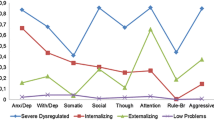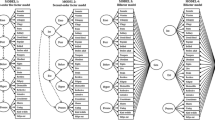Abstract
A structured psychiatric interview designed for both clinical assessment and data collection was given to 50 pairs of well-matched pediatrie and psychiatric clinic children and their mothers. The two groups were shown to be dearly distinguished on the basis of numbers of symptoms. Behavior and school symptoms gave the sharpest distinction between the two groups. Neurotic and somatic symptoms were the poorest discriminators. The psychiatric children showed significantly more antisocial symptoms than their matched pediatrie peers. Age differences showed the expected trends with the widest divergence in the number of symptoms being in the oldest age group.
Similar content being viewed by others
References
Cantwell, D., & Carlson, G. Psychiatric interview of child, Gateways Hospital. Personal communication, 1976.
Herjanic, B., Herjanic, M., Brown, F., & Wheatt, T. Are children reliable reporters?Journal of Abnormal Child Psychology, 1975,3, 41–48.
Kestenbaum, C. J., & Bird, H. R. Mental health assessment form: Childhood: Ages 7–12, 1975. Available from authors, St. Luke's Hospital Center, 411 West 114th St., New York, N.Y., 10027.
Langner, T. S., Gersten, J. C., McCarthy, E. D., Eisenberg, J. G., Greene, E. L., Herson, J. H., & Jameson, J. D. A screening inventory for assessing psychiatric impairment in children 6 to 18.Journal of Consulting and Clinical Psychology, 1976,44, 286–296.
Lapouse, R., & Monk, M. A. An epidemiological study of behavior characteristics in children.American Journal of Public Health, 1958,48, 1134–1144.
Mensh, I. N., Kantor, M. B., Domke, H. R., Gildea, M., & Glidewell, J. C. Children's behavior symptoms and their relationships to school adjustment, sex and social class.Journal of Social Issues, 1959,15, 8–15.
Rutter, M., & Graham, P. The reliability and validity of the psychiatric assessment of the child: I. Interview with the child.British Journal of Psychiatry, 1968,114, 563–579.
Rutter, M., Tizard, J., & Whitmore, K.Education, health and behavior. New York: John Wiley & Sons, 1970.
Werry, J. S., & Quay, H. C. The prevalence of behavior symptoms in younger elementary school children.American Journal of Orthopsychiatry, 1971,41, 136–143.
Wolff, S. Behavioral characteristics of primary school children referred to a psychiatric department.British Journal of Psychiatry, 1967,113, 885–893.
Author information
Authors and Affiliations
Additional information
This study was supported in part by NIMH Grant 05938.
Rights and permissions
About this article
Cite this article
Herjanic, B., Campbell, W. Differentiating psychiatrically disturbed children on the basis of a structured interview. J Abnorm Child Psychol 5, 127–134 (1977). https://doi.org/10.1007/BF00913088
Revised:
Issue Date:
DOI: https://doi.org/10.1007/BF00913088




